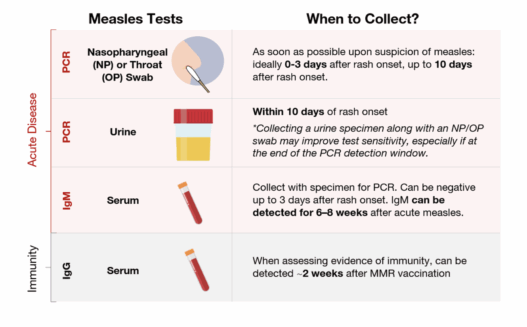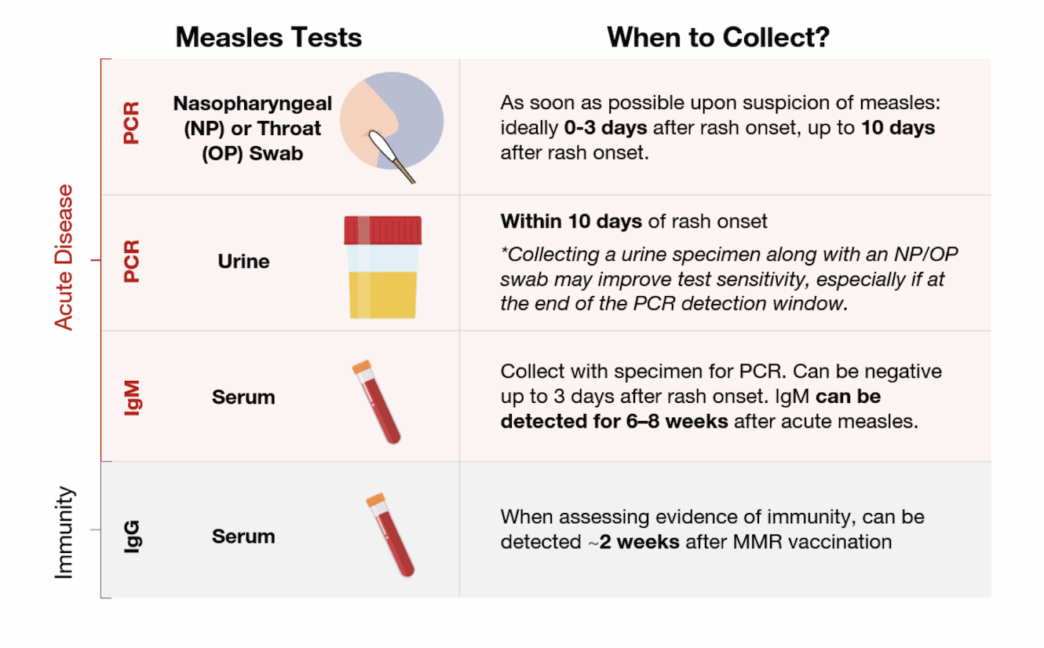While folks have gotten used to quick and easy tests that let them know if they have strep, flu, COVID and many other infections, we don’t have a test like that for measles. So, how do you test someone who might have measles?
How to Test Someone Who Might Have Measles
As with most conditions, there are different ways to test someone if you suspect they have measles.

Which is best?
“CDC recommends that either a nasopharyngeal swab, throat swab, or urine specimen as well as a blood specimen be collected from all patients with clinical features compatible with measles.
Nasopharyngeal or throat swabs are preferred over urine specimens.”
Laboratory Testing for Measles
Ideally, you will test for measles with both a nasopharyngeal or throat swab, sending this for a real-time reverse transcription PCR analysis, and a blood sample, to test for measles antibody levels.
Why not just do one or the other, instead of doing both?
Because doing both is the most accurate way to see if someone really does have measles!
Questions about Laboratory Testing for Measles
But because laboratory testing for measles isn’t as easy as a rapid test done in office, it does often lead to questions and confusion.
“Quest Diagnostics offers the Measles (Rubeola) Virus, Qualitative Real-time PCR, Nasopharyngeal/Throat test (test code 39306), a diagnostic test that detects measles RNA in clinical specimens. Quest also offers serologic tests for measles: Measles Antibody (IgM) (test code 34256); Measles Antibody (IgG) (test code 964); and Measles Antibodies (IgG, IgM) (test code 34166).”
Measles (Rubeola) Virus, Qualitative Real-time PCR, Nasopharyngeal/Throat
For example, what happens if you suspect that someone has measles, but early testing with rRT–PCR and IgM were both negative?
“If the acute-phase serum specimen collected ≤3 days after rash onset is negative, and the case has a negative (or not done) result for real-time RT-PCR (rRT-PCR), a second serum specimen collected 3–10 days after symptom onset is recommended. This is because the IgM response is not detectable in some cases until 3 days after symptom onset.”
Laboratory Testing for Measles
In this case, the tests should be repeated, because they may be false negatives.
“Detection of measles RNA is most successful when specimens are collected on the first day of rash through the 3 days following onset of rash. Detection of measles RNA by rRT–PCR may be successful as late as 10–14 days after rash onset.”
Laboratory Testing for Measles
While you do want to test folks as soon as you think they might have measles, rRT–PCR testing is most accurate on the first day their rash appears and for the next three days.
What if you only did antibody testing, but the IgM and IgG testing were both positive?
In this case, as IgM antibodies indicate an acute infection and IgG antibodies indicate long term immunity, one of the tests is wrong.
Further testing can be done by the CDC, including IgG avidity testing and a plaque reduction neutralization (PRN) assay, to help clarify if the person has measles. Ideally, though, you would just do a rRT-PCR test.
What if someone who was recently vaccinated has a positive PCR or IgM test?
“Since it is important to determine very rapidly if suspected cases are true measles cases or vaccine reactions, the CDC and APHL-VPD Reference Centers offer the Measles Vaccine (MeVA) Assay. The MeVA assay is a real-time RT-PCR assay that detects only measles vaccine strains.”
Genetic Analysis of Measles Viruses
Further testing, including measles vaccine virus detection can be done to see if the patient has a vaccine strain of measles. This would indicate that they likely have a vaccine reaction (fever and rash after their MMR) and don’t actually have measles.
What kind of swab do you use for the rRT-PCR test?
One reason that some folks only do measles antibody tests is because they aren’t familiar with the measles PCR test.
A PCR test that is much like many of the other PCR tests that they routinely order for flu and COVID. While you won’t get quick results, you can use any “commercial swab products designed for the collection of throat/nasopharyngeal specimens or flocked polyester fiber swabs” and send the refrigerated sample in standard viral transport medium to the lab.
Send it to which lab?
While you can likely send it to whichever commercial lab you typically use, like Quest or Labcorp, it is best to contact your local or state health department for further instructions if you strongly suspect that someone has measles. They will likely want to do the testing themselves.
And they can help you if you have any further questions about the results too!
More on Measles
Last Updated on May 8, 2025







